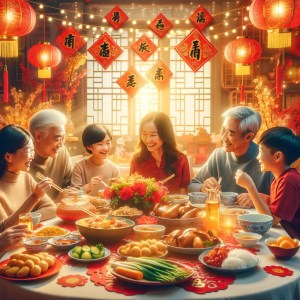- Introduction to the New Year Global Festivities
- Diverse Traditions Around the World
- Chinese New Year: A Festival of Renewal and Reunion
- Spain: Midnight Grapes for Prosperity
- The Netherlands: Oliebollen and Ancient Beliefs
- Russia: Underwater Tree Planting in Lake Baikal
- Scotland: First Footing for Good Luck
- Brazil: Floral Offerings to Yemoja
- Greece: Onions and Pomegranates – Symbols of Growth and Luck
- Japan: Soba Noodles for Longevity
- Chile: Celebrating with Ancestors in Cemeteries
- Denmark: Breaking Plates for Friendship
- Italy: Red Underwear for Fertility
- Ecuador: Burning Scarecrows for Cleansing
- Czech Republic: Apple Cutting for Fate Prediction
- Germany: Bleigießen – Predicting the Future
- Estonia: Eating Many Meals
- Armenia: Baking “Good Luck” Bread
- Ireland: Banging Bread Against the Wall
- Turkey: Sprinkling Salt for Prosperity
- Colombia: Potato Predictions
- United States: Watching the Ball Drop
- Philippines: Serving 12 Round Fruits
- Canada: Ice Fishing
- Universal Tradition: Making New Year’s Resolutions
- Historical Perspectives
- Food Symbolism in New Year Celebrations
- Conclusion to New Year Traditions from Around the World
Introduction to the New Year Global Festivities

Embracing the New Year: A Global Perspective
As the calendar turns to a new page, the world comes alive with a mosaic of New Year traditions, each rich with heritage and symbolism. From the grape-eating rituals of Spain to the vibrant underwater tree planting in Russia’s Lake Baikal, these customs reflect the diverse ways in which cultures across the globe welcome the dawn of a new beginning. In this comprehensive exploration, we delve into the heart of these global festivities, unraveling their origins, meanings, and the unity they bring to humankind.
Symbolism and Significance: Understanding the Essence of New Year Celebrations
New Year’s Eve isn’t just a transition from one year to the next; it’s a tapestry of cultural narratives that encapsulate hope, renewal, and reflection. In this section, we’ll explore the deep-seated symbolism behind these global customs, from the auspicious color red in Italy’s underwear tradition to the prosperity heralded by legumes in Southern United States. Through this journey, we aim to provide a deeper understanding of how these traditions transcend mere celebration, embedding themselves in the cultural ethos of societies around the world.
Diverse Traditions Around the World
Chinese New Year: A Festival of Renewal and Reunion

Celebrating the Lunar New Year
Chinese New Year, also known as the Spring Festival, marks the beginning of the lunar calendar and is the most significant traditional holiday in China. This vibrant celebration extends over 15 days, culminating in the Lantern Festival. It’s a time for families to gather, honor ancestors, and embrace the coming spring.
Traditions and Symbolism
Festivities include decorating homes with red lanterns and couplets, symbolizing luck and prosperity. Fireworks and lion dances are common, intended to ward off evil spirits. The giving of red envelopes (‘hongbao’), filled with money, is a practice to transfer fortune and blessings, especially to children and elders.
Culinary Customs
Food plays a central role in the festivities, with each dish carrying symbolic meaning. For instance, dumplings represent wealth, fish signifies abundance, and glutinous rice cakes symbolize progress and growth. The reunion dinner on New Year’s Eve is a pivotal event, bringing families together in a feast that celebrates unity and abundance.
The Chinese New Year is not just a time of joy and festivity; it’s a profound cultural observance that blends traditions, family values, and hopes for a prosperous and healthy new year.
Spain: Midnight Grapes for Prosperity

In the heart of Spain’s New Year’s celebration lies a unique tradition: eating 12 grapes at midnight, each symbolizing good fortune for the upcoming months. This practice, originating in the late 19th century, not only embodies the spirit of the season but also reflects the ingenuity of vine growers in Alicante, turning a surplus of grapes into a nationwide ritual of prosperity and hope.
The Netherlands: Oliebollen and Ancient Beliefs
The Dutch welcome the New Year with a peculiar yet intriguing tradition of eating oliebollen, deep-fried dough balls. This custom traces back to ancient Germanic tribes who believed that eating these fatty treats would protect them from Perchta, a mythical figure known for her harsh punishment of those lacking in Yule spirit. Today, oliebollen are a festive staple, symbolizing resilience and celebration of the New Year.
Russia: Underwater Tree Planting in Lake Baikal
In a striking blend of tradition and adventure, Russian New Year’s celebrations include planting a New Year Tree underwater in Lake Baikal. This tradition, involving divers named Father Frost and the Ice Maiden, is a relatively recent addition but has quickly become a hallmark of Russian festivities. Despite freezing temperatures, participants from around the world gather to witness this unique celebration of life and renewal beneath the ice.
Scotland: First Footing for Good Luck

The Scottish New Year, or Hogmanay, is steeped in the tradition of ‘first footing.’ According to local lore, the first person to enter a home after midnight, preferably a dark-haired male, brings with them good fortune for the year. They often carry gifts like coal, salt, shortbread, and whiskey, symbolizing warmth, flavor, good cheer, and good spirits. This tradition, rooted in the desire to avoid Viking invaders, now signifies the welcoming of prosperity and success.
Brazil: Floral Offerings to Yemoja
Brazil’s New Year’s Eve is marked by a beautiful tradition of making offerings to Yemoja, a deity of the seas. People flock to the shores, casting white flowers and candles into the ocean as tokens of gratitude and requests for blessings. Donning white attire and jumping over seven waves while making wishes, Brazilians blend ancient rituals with contemporary celebrations, embodying a deep connection with nature and the divine.
Greece: Onions and Pomegranates – Symbols of Growth and Luck
Greek New Year traditions are rich with symbolism. Onions, representing rebirth and growth, are hung on doors to promote a prosperous year. Moreover, the smashing of a pomegranate at the doorstep just after midnight is a practice believed to bring abundant good fortune, with the scattered seeds symbolizing prosperity and good luck. These customs intertwine ancient myths with modern hopes, encapsulating the Greek spirit of renewal and abundance.
Japan: Soba Noodles for Longevity

In Japan, toshikoshi soba, or year-crossing noodles, are a culinary tradition on New Year’s Eve. The long, thin soba noodles symbolize a wish for longevity and prosperity. This custom, while shrouded in mystery regarding its origins, reflects the Japanese values of resilience and health, as the buckwheat plant used to make soba is known for its hardiness.
Chile: Celebrating with Ancestors in Cemeteries
In a poignant blend of remembrance and celebration, Chileans observe New Year’s Eve by gathering in cemeteries. This unique tradition involves holding masses and spending time with deceased loved ones, integrating them into the festivities. This practice highlights the Chilean emphasis on family and the continuum of life, bringing a deeper, more reflective dimension to New Year’s Eve.
Denmark: Breaking Plates for Friendship
In Denmark, a peculiar yet heartwarming tradition involves breaking plates against friends’ and neighbors’ doors on New Year’s Eve. This act of shattering china symbolizes leaving behind any aggression and ill-will, paving the way for good fortune in the year ahead. The larger the pile of broken dishes, the more luck and friendship one can expect. This tradition reflects the Danish spirit of camaraderie and the value placed on strong community bonds.
Italy: Red Underwear for Fertility

In Italy, the New Year ushers in with a colorful tradition: wearing red underwear. Rooted in the belief that red symbolizes fertility, Italians don this vibrant attire under their clothes, hoping to bring love and prosperity in the coming year. This charming custom not only highlights cultural beliefs about color and fortune but also adds a playful and intimate element to the New Year celebrations.
Ecuador: Burning Scarecrows for Cleansing
Ecuador’s New Year’s Eve is illuminated by the burning of effigies, representing figures from the past year. Known as the “año viejo” or “old year,” these bonfires serve as a ritual cleansing, bidding farewell to the negatives of the past and welcoming the positives of the future. This dramatic and symbolic tradition exemplifies the Ecuadorian approach to renewal and hope for the new year.
Czech Republic: Apple Cutting for Fate Prediction
In the Czech Republic, predicting the future is a part of the New Year’s Eve ritual. By cutting an apple in half, the shape of its core is believed to determine the fate of those present. A star-shaped core predicts happiness and health, while a cross suggests impending challenges. This tradition reflects the Czech focus on family and communal gathering, as well as the hopes and anxieties that accompany the turn of the year.
Germany: Bleigießen – Predicting the Future

Germany’s New Year’s Eve is characterized by Bleigießen, a tradition of lead pouring. Melting a small piece of lead or tin over a candle and then plunging it into cold water, the resulting shape is interpreted to predict one’s fortune for the upcoming year. This unique custom combines elements of fun and superstition, offering a glimpse into the German approach to the new year as a time of reflection and foresight.
Estonia: Eating Many Meals
Estonians have a unique approach to celebrating New Year’s Eve: they believe in eating seven, nine, or twelve meals to bring about good fortune. These numbers are considered lucky in Estonia, and the tradition also involves leaving food on plates for visiting spirit family members. This practice not only symbolizes abundance and prosperity but also reflects a deep cultural connection to ancestors and the spirit world.
Armenia: Baking “Good Luck” Bread
In Armenia, baking bread on New Year’s Eve incorporates more than just flour and water; it’s about infusing each loaf with good wishes and luck. This tradition of kneading metaphorical blessings into the bread exemplifies the Armenian emphasis on nourishing both the body and the spirit, marking the year’s end with an act of communal care and hope.
Ireland: Banging Bread Against the Wall

Irish New Year’s customs include the unique practice of banging Christmas bread against the doors and walls of homes. This action is believed to chase away evil spirits and invite good spirits in, symbolizing the cleansing of the old and welcoming of the new. It’s a tradition that combines superstition with the hope for a fresh start and good luck in the New Year.
Turkey: Sprinkling Salt for Prosperity
In Turkey, the arrival of the New Year is marked by the tradition of sprinkling salt on one’s doorstep at midnight. This act is believed to bring peace and prosperity throughout the coming year. Reflecting the Turkish emphasis on hospitality and well-being, this simple yet symbolic practice demonstrates the cultural value placed on ushering in the New Year with positive intentions and blessings.
Colombia: Potato Predictions
In Colombia, a unique tradition involves placing three potatoes under the bed – one peeled, one unpeeled, and one half-peeled. At midnight, reaching under the bed and picking a potato is believed to foretell one’s financial fortunes for the coming year. This practice reflects the Colombian blend of superstition and optimism at the turn of the year.
United States: Watching the Ball Drop

One of the most iconic New Year’s Eve traditions in the United States is watching the ball drop in New York City’s Times Square. Accompanied by celebrations and special foods like collard greens and black-eyed peas in the American South, this event symbolizes the communal spirit of ringing in the New Year and the widespread hope for prosperity and good fortune.
Philippines: Serving 12 Round Fruits
In the Philippines, serving 12 round fruits on New Year’s Eve is a tradition symbolizing prosperity and good fortune for each month of the new year. The circular shape of the fruits is thought to represent coins, attracting financial success and well-being. This custom showcases the Filipino emphasis on abundance and the hope for a prosperous year ahead.
Canada: Ice Fishing
In Canada, a popular cold-weather activity to celebrate the New Year is ice fishing. Many engage in this tradition as a way of embracing the winter season and spending quality time together. Providing heated huts and equipment, it’s a communal and unique way to welcome the new year, reflecting the Canadian spirit of resilience and camaraderie in the face of chilly winters.
Universal Tradition: Making New Year’s Resolutions

Origins and Evolution of New Year’s Resolutions
- Babylonian Beginnings: The tradition of making New Year’s resolutions dates back about 4,000 years to ancient Babylon. During their Akitu festival, a 12-day event marking the new year, the Babylonians made promises to their gods to return borrowed items and pay debts. These commitments are considered the precursors to modern New Year’s resolutions. The favor of the gods was believed to be contingent upon the fulfillment of these promises.
- Roman Adaptation and the God Janus: The Romans, under Julius Caesar, who established January 1st as the beginning of the new year around 46 B.C., also embraced this tradition. They made resolutions of good conduct for the coming year as offerings to Janus, the two-faced god representing doorways and transitions, symbolizing looking back into the past and forward into the future.
Cultural and Religious Influences
- Early Christian Practices: The early Christian tradition transformed New Year’s resolutions into a reflective practice. In 1740, John Wesley, the founder of Methodism, introduced the Covenant Renewal Service held during New Year’s Eve or New Year’s Day. These services involved scripture readings, hymn singing, and resolutions for betterment, serving as a spiritual alternative to more raucous celebrations. This practice remains popular, especially in evangelical Protestant churches and African American congregations.
- Secularization in the Modern Era: Despite their religious origins, New Year’s resolutions have evolved into a largely secular practice focused on self-improvement. Modern resolutions range from health and fitness goals to career and personal development ambitions. While a significant portion of people make New Year’s resolutions, the success rate in achieving these goals remains relatively low, highlighting the challenges of maintaining these commitments. This shift reflects a broader societal focus on individual progress and self-discipline.

Historical Perspectives
From Ancient Babylon to Modern Times: The Evolution of New Year Celebrations
- Ancient Babylonian Beginnings: The earliest known New Year celebrations date back 4,000 years to ancient Babylon. The Babylonians marked the new year with the Akitu festival in late March, coinciding with the planting of crops. This event was not just a time of festivity but also held political and religious significance, involving the crowning of a king or reaffirming the current ruler’s mandate.
- Worldwide Civilizations and their Calendars: Various ancient civilizations developed their own ways of recognizing the new year, often linking it to agricultural or astronomical events. For example, in Egypt, the new year began with the annual flooding of the Nile, while the Lunar New Year in Asia corresponded with the second new moon after the winter solstice.
Roman Contributions: Janus and the January Celebration
- Early Roman Calendar and Reforms: The Roman calendar initially consisted of 10 months and 304 days, with the year starting at the vernal equinox. Later reforms by Numa Pompilius added the months of January and February. The introduction of the Julian calendar by Julius Caesar in 46 B.C. established January 1st as the first day of the year, in honor of Janus, the god of beginnings. The Romans celebrated with sacrifices, gift exchanges, and parties, setting a precedent for many modern New Year’s traditions.
Food Symbolism in New Year Celebrations
Legumes for Prosperity: Italy and Southern U.S. Traditions
- Symbolic Foods for Financial Success: In various cultures, certain foods consumed during New Year’s celebrations are symbolic of prosperity and financial success. For instance, in Italy and the southern United States, legumes like lentils and black-eyed peas are favored for their resemblance to coins, symbolizing future financial prosperity.
Pork, Cakes, and Puddings: Diverse Cultural Practices
- Pork as a Symbol of Progress: Pork, representing progress and prosperity, features in the New Year’s meals of countries like Cuba, Austria, Hungary, and Portugal. The consumption of pork is rooted in the belief that pigs symbolize progress and prosperity.
- Circular Foods Completing the Year’s Cycle: Ring-shaped cakes and pastries, signifying the completion of the year’s cycle, are common in the Netherlands, Mexico, Greece, and other countries. This shape represents the year coming full circle, a reflection of continuity and completion.
- Hidden Almonds in Scandinavian Desserts: In Sweden and Norway, the tradition of serving rice pudding with a hidden almond on New Year’s Eve is prevalent. The person who finds the almond is believed to be blessed with good fortune for the entire year.

Resolutions – Then and Now
Ancient Origins: Babylonian and Roman Traditions
- Babylonian Promises: The Babylonians were among the first to establish the practice of making resolutions. During Akitu, their New Year festival, they made promises to the gods to ensure favor and prosperity. This tradition laid the groundwork for the concept of New Year’s resolutions as we know it today.
- Roman Rituals with Janus: In ancient Rome, resolutions took on a more personal and moral character. Romans made promises of good conduct to Janus, the two-faced god, reflecting a desire for personal improvement and ethical behavior.
Evolution of New Year’s Resolutions
- Medieval to Modern Transformations: During the Middle Ages, knights renewed their vow to chivalry as a form of resolution. As time progressed, especially by the 17th century, the tradition of making New Year’s resolutions became more widespread, often focusing on bettering one’s self. This shift from public vows to personal improvement continues into modern times, where resolutions often center on health, fitness, and self-improvement goals.
- Contemporary Practice and Challenges: Today, resolutions are predominantly secular and focus on self-improvement. Despite the high rate of people making resolutions each year, success rates in maintaining them remain relatively low. This modern take on resolutions reflects not just personal goals but broader societal values such as responsibility, financial wealth, and self-discipline.

Conclusion to New Year Traditions from Around the World
Global Unity in Diversity: The Shared Spirit of New Year Traditions and Celebrations
New Year’s celebrations, with their myriad traditions, are a testament to the diversity and unity of human culture. Each custom, from the grape-eating of Spain to the bellringing in Japan, weaves a unique thread in the global tapestry of celebration. These traditions, steeped in symbolism and heritage, serve not just as a means of festivity but as a reflection of each culture’s values and hopes for the future.

Reflecting and Renewing: Embracing the Promise of the New Year
The New Year is universally seen as a time of reflection, renewal, and resolution. Across the world, people engage in introspection, contemplating their past actions and setting goals for personal growth and improvement. This period of reflection is followed by a renewal, a chance to start anew with fresh perspectives and renewed vigor. Whether it’s the burning of regrets in Japan or the mindful practices encouraged in therapy, these acts symbolize the human desire to grow, improve, and move forward with optimism and hope.
As we bid farewell to the old year and welcome the new, let us embrace the spirit of unity and renewal that New Year’s embodies. It’s a time to cherish our shared human experiences, to learn from our past, and to look forward with anticipation to the opportunities and challenges ahead. May this New Year bring joy, growth, and prosperity to all. Happy New Year!
Check Out These Other Great Articles:
- Countdown to the New Year 2024
- The Various Holidays in December: The Joy of Celebrating Winter Holidays
- Unveiling the Mystique of Blue Seal Silver Certificates: A Journey Through U.S. Monetary History
- The Enigmatic $2 Dollar Bill: Unraveling the Secrets of America’s Rarest Currency
- Embrace Everyday Adventures with Mounteen: Your Gateway to an Exciting Life!
- Ultimate Guide to Assistance Programs in the U.S.: Federal, National, and State-Specific Support















